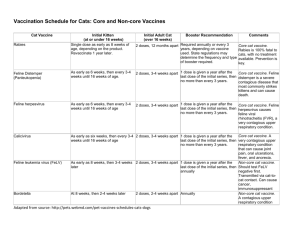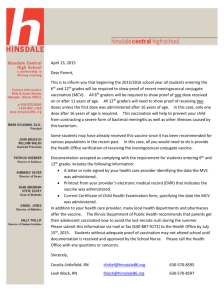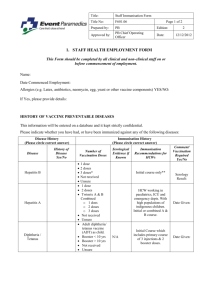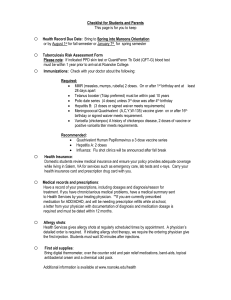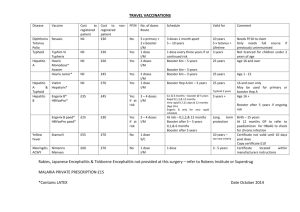File
advertisement
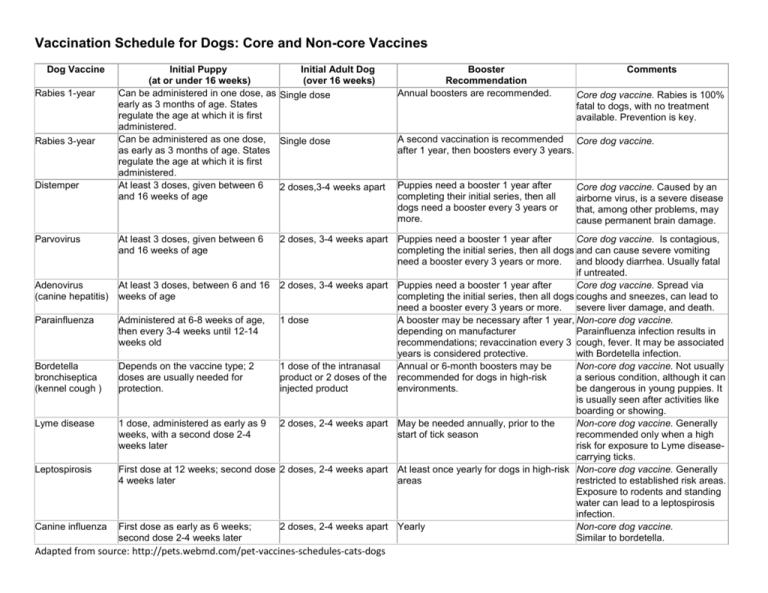
Vaccination Schedule for Dogs: Core and Non-core Vaccines Dog Vaccine Rabies 1-year Rabies 3-year Distemper Parvovirus Adenovirus (canine hepatitis) Parainfluenza Bordetella bronchiseptica (kennel cough ) Lyme disease Leptospirosis Canine influenza Initial Puppy Initial Adult Dog (at or under 16 weeks) (over 16 weeks) Can be administered in one dose, as Single dose early as 3 months of age. States regulate the age at which it is first administered. Can be administered as one dose, Single dose as early as 3 months of age. States regulate the age at which it is first administered. At least 3 doses, given between 6 2 doses,3-4 weeks apart and 16 weeks of age Booster Recommendation Annual boosters are recommended. Comments Core dog vaccine. Rabies is 100% fatal to dogs, with no treatment available. Prevention is key. A second vaccination is recommended Core dog vaccine. after 1 year, then boosters every 3 years. Puppies need a booster 1 year after completing their initial series, then all dogs need a booster every 3 years or more. Core dog vaccine. Caused by an airborne virus, is a severe disease that, among other problems, may cause permanent brain damage. Core dog vaccine. Is contagious, 2 doses, 3-4 weeks apart Puppies need a booster 1 year after completing the initial series, then all dogs and can cause severe vomiting need a booster every 3 years or more. and bloody diarrhea. Usually fatal if untreated. Core dog vaccine. Spread via At least 3 doses, between 6 and 16 2 doses, 3-4 weeks apart Puppies need a booster 1 year after weeks of age completing the initial series, then all dogs coughs and sneezes, can lead to need a booster every 3 years or more. severe liver damage, and death. Administered at 6-8 weeks of age, 1 dose A booster may be necessary after 1 year, Non-core dog vaccine. then every 3-4 weeks until 12-14 depending on manufacturer Parainfluenza infection results in weeks old recommendations; revaccination every 3 cough, fever. It may be associated years is considered protective. with Bordetella infection. Non-core dog vaccine. Not usually Depends on the vaccine type; 2 1 dose of the intranasal Annual or 6-month boosters may be doses are usually needed for product or 2 doses of the recommended for dogs in high-risk a serious condition, although it can protection. injected product environments. be dangerous in young puppies. It is usually seen after activities like boarding or showing. Non-core dog vaccine. Generally 1 dose, administered as early as 9 2 doses, 2-4 weeks apart May be needed annually, prior to the weeks, with a second dose 2-4 start of tick season recommended only when a high weeks later risk for exposure to Lyme diseasecarrying ticks. First dose at 12 weeks; second dose 2 doses, 2-4 weeks apart At least once yearly for dogs in high-risk Non-core dog vaccine. Generally 4 weeks later areas restricted to established risk areas. Exposure to rodents and standing water can lead to a leptospirosis infection. Non-core dog vaccine. First dose as early as 6 weeks; 2 doses, 2-4 weeks apart Yearly second dose 2-4 weeks later Similar to bordetella. At least 3 doses, given between 6 and 16 weeks of age Adapted from source: http://pets.webmd.com/pet-vaccines-schedules-cats-dogs

